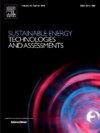新兴绿色和可持续能源领域的生命周期评估和循环经济:综述
IF 7.1
2区 工程技术
Q1 ENERGY & FUELS
Sustainable Energy Technologies and Assessments
Pub Date : 2025-07-07
DOI:10.1016/j.seta.2025.104436
引用次数: 0
摘要
新兴的绿色和可持续能源(GSE)行业,如电动汽车(ev)和绿色氢(GH),对于实现全球脱碳目标至关重要。本研究采用PRISMA方法,从Scopus和Web of Science数据库中发表的157篇文章中获得了重要的见解。研究发现,循环经济与生命周期评价相结合,通过对环境影响的有效评价,具有明显的可持续性效益。确定的主要差距是方法差异、CE-LCA研究的地理集中、对实际应用的关注有限以及未包括社会经济方面。该研究强调了CE-LCA在资源效率方面的作用,特别是在电池回收和GH生产方面。此外,方法统一和政策一致框架的采用对CE-LCA模型的实际应用产生了重大影响。值得注意的是,电池的二次使用和废物制氢系统被发现是降低全球变暖潜势和改善循环结果的有希望的策略。该研究建议将CE-LCA框架标准化,开发特定区域的生命周期清单数据库,并将其纳入政策和监管框架。此外,将人工智能、机器学习和物联网整合到CE-LCA实践中,对于提高数据质量、实现实时监控和支持可持续性评估至关重要。本文章由计算机程序翻译,如有差异,请以英文原文为准。

Life Cycle Assessment and Circular Economy in Emerging Green and Sustainable Energy Sectors: A Critical Review
Emerging green and sustainable energy (GSE) sectors, such as electric vehicles (EVs) and green hydrogen (GH) are crucial for achieving the global decarbonization goals. This study provides critical insights from 157 articles published in Scopus and Web of Science databases by employing PRISMA approach. It was found that combining circular economy (CE) with life cycle assessment (LCA) offers clear sustainability benefits though effective evaluation of environmental impacts. Major identified gaps are methodological variations, geographical concentration of CE-LCA studies, limited focus on real-world applications, and non-inclusion of socio-economic dimensions. The study highlights the role of CE-LCA in resource efficiency, particularly in battery recycling and GH production. Furthermore, adoption of methodological harmonization and policy-aligned frameworks were found to significantly influence the practical application of CE-LCA models. Notably, second-life applications of batteries and waste-to-hydrogen systems were found to be promising strategies to reduce the global warming potential and improve the circularity outcomes. The study recommends the standardization of CE-LCA frameworks, development of region-specific life cycle inventory databases, and their inclusion into policy and regulatory frameworks. Additionally, the integration of artificial intelligence, machine learning, and internet of things into CE-LCA practices is essential to enhance data quality, enable real-time monitoring, and support sustainability assessments.
求助全文
通过发布文献求助,成功后即可免费获取论文全文。
去求助
来源期刊

Sustainable Energy Technologies and Assessments
Energy-Renewable Energy, Sustainability and the Environment
CiteScore
12.70
自引率
12.50%
发文量
1091
期刊介绍:
Encouraging a transition to a sustainable energy future is imperative for our world. Technologies that enable this shift in various sectors like transportation, heating, and power systems are of utmost importance. Sustainable Energy Technologies and Assessments welcomes papers focusing on a range of aspects and levels of technological advancements in energy generation and utilization. The aim is to reduce the negative environmental impact associated with energy production and consumption, spanning from laboratory experiments to real-world applications in the commercial sector.
 求助内容:
求助内容: 应助结果提醒方式:
应助结果提醒方式:


